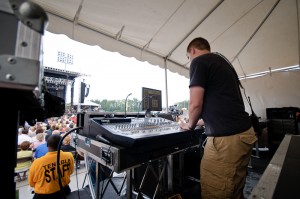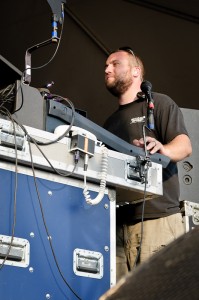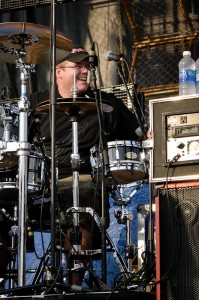When I started my last blog post “Avon Calling“, I had no idea it would end up where it did. So I ran out of room for some of the other text and images that I wanted share from Thursday night’s Joe Nichols show in Avon, Ohio. Don’t worry, this post will be like lunch the day after Thanksgiving – lots of unrelated leftovers that are still good after the main meal.
The previous post focused on people working behind the scenes, so I thought it only fitting to highlight the unsung heroes of Joe’s crew. There are several people involved with Joe’s career and tour (agent, management, publicist, record label folks, and tour manager), but I thought I would focus on the guys in the trenches at every show. You’ve seen them at shows – cargo shorts, black t-shirt, walkie-talkie – scurrying about like ants moving a giant sequoia tree, one leaf at a time. They are usually the first ones in the venue and the last to leave at night, often putting in 12 – 14 hour days. Without them, the show simply would not happen.

If you’ve been following my blathering for any length of time, you’ll know that my son, Chris, has worked for country artist Joe Nichols for a couple years. During that time, he has served as the Front of House Sound Engineer, and last year became the tour’s Production Manager, as well. I won’t begin to pretend that I could list all of his tasks and duties, but I’ll try to cover what I know. Chris’ work for a specific show begins weeks before the show date. As Production Manager, he interfaces with the venue, the contractor supplying the sound and light systems, and any other necessary parties to go over all the technical needs for that show (sufficient power, the kind of speakers, any needed backline gear for fly dates, stagehands, etc.). He also works with equipment companies to obtain endorsement or discount deals for specific products they use. Chris also handles their own equipment needs (mixing consoles, microphones, direct boxes, wireless systems, interface equipment), as well procuring expendable items for the band and crew (batteries, guitar strings, picks, gaffer tape, parts, etc.).

On show day, all three crew members unload their equipment trailer, with the help of the locally-hired stagehands. All of the cases are rolled or carried to the stage and set up, or put in a staging area if another act is headlining and sets up first. When they are cleared to take the stage, all the gear is set up – drums, keyboards, guitar amps and pedal boards, mic stands, microphones, monitor console, and the front of house mixing console. Hundreds of cables are run to and from the stage, and between items on stage. Once this is complete, Chris “tunes” the PA system. This is where certain test signals and various reference recordings are played through the system, as he evaluates the characteristics of that particular system in that particular venue. Every day is different, so tuning the system to get a good starting point is critical. Once he has dialed in any needed adjustments, band members take the stage with their instruments and begin the soundcheck. Since most of the settings on Chris’ console are saved for each song, much of it can be recalled at the touch of a button. But it is still necessary to run through a few songs with the band, to verify everything is working properly and to fix anything that isn’t.
Once the show begins, Chris’s primary task is mixing the dozens of signals coming from the band’s instruments and microphones to create a pleasing mix for the audience. While the show is underway, his hands are in constant motion, adjusting levels, switching effects on and off, and dialing in the perfect blend of all the elements. After the show, Chris and the rest of the crew pack up the gear, load up the trailer and prepare to do it all again the next day.

Ryan is the monitor engineer for Joe’s tour. Although he is also involved in all of the unloading, set up, connecting, and tear-down of the stage gear, his primary function at soundcheck and during the show is to mix all band’s instruments and vocals into separate feeds for each of the performers’ in-ear monitors or floor wedges. This is an important task, since much of the way an artist performs is based on how well they can or cannot hear what is going on. Imagine trying to mix all the inputs from a band, in real time during a show, to get a pleasing balance. Now multiply that by 7 or more, and you get the idea of what the monitor engineer is up to over on the side of the stage. Another one of Ryan’s tasks at each venue is determine what radio frequencies can be used for the wireless microphones, wireless guitar setups, and wireless in-ear monitor systems. Once all the necessary units are adjusted and tested, they are handed out to the band for use during soundcheck and the show. Also, if anything goes wrong with the band’s gear or sound system during the show, Ryan is the one to dart onstage to swap out a bad cable or troubleshoot a problem.

The third member of Joe’s “men in the trenches” is Taylor. Like Chris and Ryan, Taylor helps with the gear load-in, setup and connection. But later in the day, Taylor is found at the merchandise table in the venue, selling T-shirts, and other “merch” to the loyal fans. Besides just selling these items, Taylor is responsible for all aspects of the merch part of the tour – procuring the items (which can often be tricky when you’re in a different city every day), sorting and tracking all the items, and dealing with the promotor or venue regarding any percentages they are owed. At some shows, the venue’s staff sells the merchandise for the artist, so Taylor often hangs out near the stage to help out with any issues.
So as you can see, this triumvirate of titans handles way more at each show than most people will ever know. Ironically, when they’re doing their jobs well, you don’t even notice them. So if you happen to see Joe live someday, show some love for these guys out there working hard, gettin’ it done for Joe, his band, and especially for the fans.
As always, thanks for visiting the blog!
